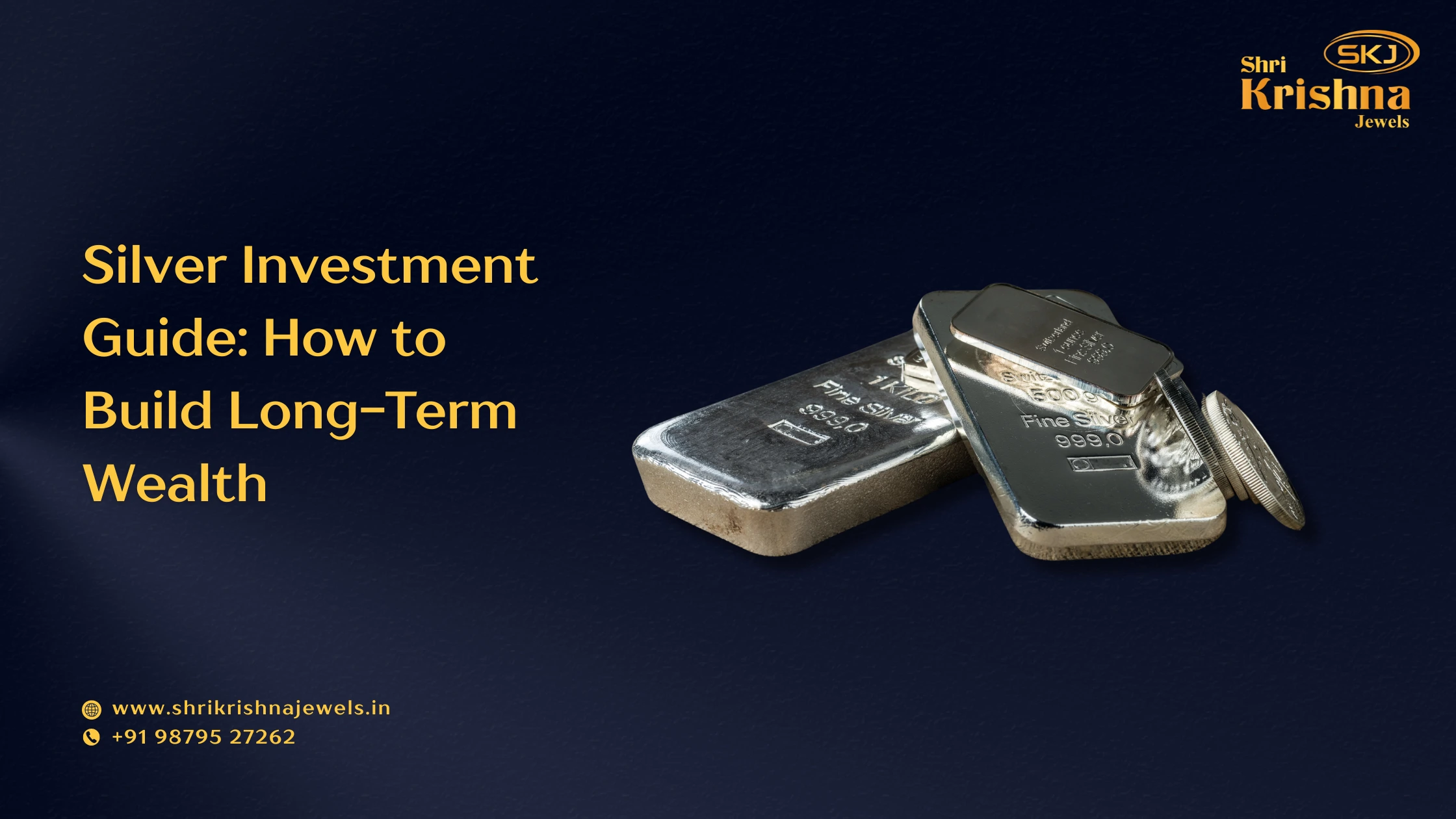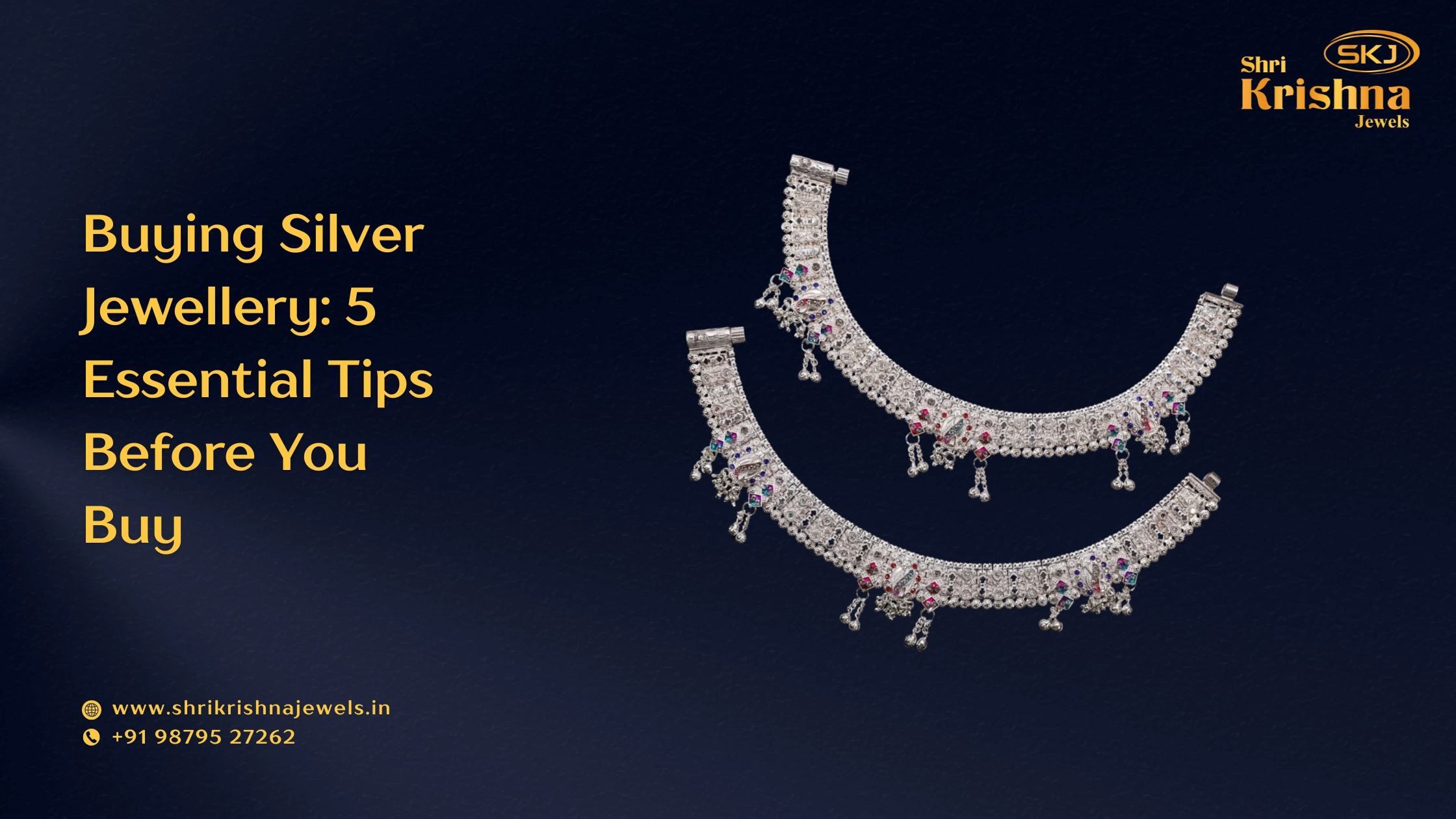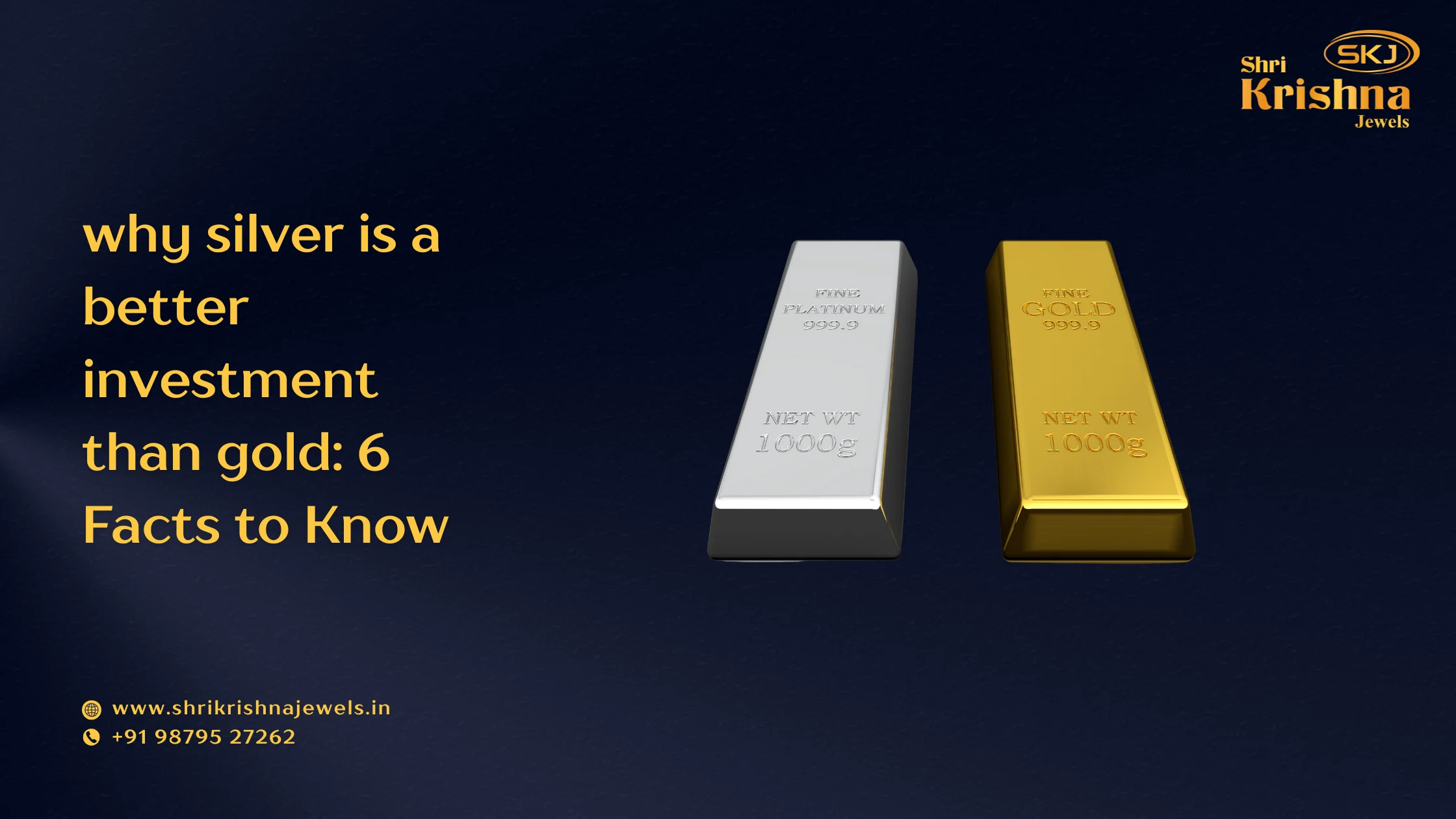Introduction
Are you tired of feeling overwhelmed or uncertain every time you shop for silver jewellery? Maybe you’ve wondered how to spot genuine pieces, find the best value, or simply choose styles that truly reflect your personality. You’re not alone-many jewellery lovers face the same questions, and that’s exactly why you’re here.
In this silver investment guide, we’ll explore how to make smart, stylish, and secure choices when buying silver. Whether you’re searching for a timeless piece to treasure or looking to build wealth through precious metals, you deserve a shopping experience that’s both enjoyable and trustworthy. We understand how important it is to feel confident in your investment, and we’re here to help you every step of the way.
By the end of this blog, you’ll learn how to identify authentic silver, discover the best ways to invest, and pick out jewellery that suits your taste and budget. Ready to find your perfect silver piece? Visit Shri Krishna Jewels, where quality meets trust, and let us help you shine with confidence!
✨ Understand the Value: Why Silver is a Smart Investment
Silver is a unique asset that offers benefits you won’t find in many other investments. This silver investment guide will help you understand exactly why silver deserves a place in your portfolio.
1. Dual Nature: Industrial and Precious
Silver is both an industrial metal and a precious asset. Its role in manufacturing is enormous-used in electronics, medical devices, batteries, and even water purification. This industrial demand creates a strong, consistent market for silver, regardless of what’s happening in the world of finance.
At the same time, silver is a classic store of value. For centuries, people have turned to silver (and gold) as a way to protect their wealth when economies become unstable or currencies lose value.
2. Hedge Against Inflation
Inflation eats away at the value of cash over time. When prices rise, the money in your bank account buys less and less. Silver, on the other hand, tends to hold its value or even increase during times of high inflation. That’s why many investors use silver as a hedge-a way to protect their purchasing power no matter what happens to the economy.
3. Affordable Entry Point
Unlike gold, which can be prohibitively expensive for new investors, silver is much more accessible. You can start with just a few hundred or even a few thousand rupees or dollars. This lower entry cost makes it easy to add silver to your investment mix, even if you’re just starting out.
4. Portfolio Diversification
Smart investors know not to put all their eggs in one basket. Silver’s price movements don’t always follow the stock market, so adding it to your portfolio can help balance out risk. When stocks are down, silver might be up-and vice versa. This diversification is a key principle in any silver investment guide.
💡 Tip: As you build your investment portfolio, consider how silver can help you balance risk and reward. Even a small allocation to silver can make a big difference over time.
✨ Types of Silver Investments You Should Know
One of the best things about silver is how many ways you can invest in it. This silver investment guide covers the most popular options, so you can choose what fits your style and goals.
1. Physical Silver: Bars, Coins, and Jewellery
Physical silver is the most direct way to own this precious metal. You can buy silver bars in various sizes, from small 10-gram bars to hefty 1-kilogram bricks. Silver coins, like the American Silver Eagle or Canadian Maple Leaf, are popular with collectors and investors alike. Even silver jewellery can be a form of investment, though it’s important to understand that jewellery often carries higher premiums due to craftsmanship.
Owning physical silver gives you tangible wealth-something you can hold in your hand. It’s private, portable, and not dependent on any financial institution.
2. Silver ETFs (Exchange-Traded Funds)
If you prefer a more hands-off approach, silver ETFs are a great option. These funds are traded on stock exchanges and track the price of silver. When you buy shares in a silver ETF, you’re essentially buying a piece of a large pool of silver held by the fund.
Silver ETFs are easy to buy and sell, require no storage, and are perfect for investors who want exposure to silver without the hassle of handling physical metal.
3. Silver Mining Stocks
Another way to invest in silver is by buying shares of companies that mine and produce silver. These stocks can offer higher returns than silver itself, especially when silver prices are rising. However, they also come with higher risk, since company performance depends on management, mining costs, and other factors beyond just the price of silver.
4. Silver Futures and Options
For experienced investors, silver futures and options offer a way to speculate on the future price of silver. These are complex financial instruments that can deliver big rewards-but also big losses. They’re not recommended for beginners, but they’re worth mentioning in any comprehensive silver investment guide.
5. Digital Silver
In recent years, digital silver platforms have emerged, allowing you to buy and sell fractional units of silver online. Your silver is stored securely by the platform, and you can buy or sell at any time. This is a convenient option for small investors or those who want to avoid storage hassles.
📌 Think about your comfort level and financial goals. Start simple-maybe with physical silver or a silver ETF-then diversify as you gain experience and confidence.
✨ Buying Physical Silver: What to Look For
If you decide to buy physical silver, it’s important to know what you’re getting. This section of the silver investment guide will help you make smart, safe purchases.
1. Purity Matters
Always check the purity of the silver you’re buying. Investment-grade silver is usually marked “.999” (99.9% pure) or “.9999” (99.99% pure). Sterling silver, often used in jewellery, is marked “925” (92.5% pure). The higher the purity, the more valuable the silver.
2. Reputable Dealers
Buy only from trusted, reputable dealers. Look for established bullion dealers, reputable jewellers, or official government mints. Avoid deals that seem too good to be true-counterfeit silver is a real risk.
3. Bullion, Coins, or Collectibles?
- Bullion bars are best for those focused purely on investment value.
- Coins are great for smaller investments or gifts, and some coins may become collectibles over time.
- Collectibles (numismatic coins) can be valuable, but their price depends on rarity and demand, not just silver content.
4. Documentation and Authentication
Always get a receipt and, if possible, a certificate of authenticity. These documents are crucial if you ever want to sell your silver or prove its value.
5. Pricing and Premiums
Understand that you’ll pay a premium above the spot price of silver-this covers manufacturing, distribution, and dealer profit. Compare prices from several sources before buying.
💡 Tip: When in doubt, stick to well-known products like government-minted coins or bars from established brands. This makes buying, selling, and verifying your silver much easier.
✨ Storage & Safety: Protecting Your Silver Assets
Owning physical silver means you need to think about storage and security. This silver investment guide wouldn’t be complete without advice on keeping your investment safe.
1. Home Storage
A high-quality home safe is a good option for small to moderate amounts of silver. Choose a safe that’s fireproof, waterproof, and securely anchored. Keep your safe in a discreet location and limit who knows about it.
2. Bank Lockers
For larger holdings, a bank safety deposit box offers added security. Your silver is protected against theft and natural disasters, and you can access it during banking hours. There’s a small annual fee, but the peace of mind is worth it for many investors.
3. Insured Storage Services
Professional bullion storage services offer maximum security, insurance, and sometimes even online account management. These services store your silver in high-security vaults and insure it against loss or theft.
4. Avoid Risky Locations
Never keep large amounts of silver in easily accessible places like drawers or cupboards. Not only is this risky, but it may also void insurance coverage in case of theft.
5. Keep Records
Maintain a detailed inventory of your silver holdings, including purchase receipts, certificates, and photos. This will be invaluable for insurance claims or future sales.
📌 Treat silver storage as a key part of your wealth management plan. Good security protects your investment and your peace of mind.
✨ When to Buy and Sell: Timing the Silver Market
Timing can make a big difference in your investment results. This silver investment guide will help you understand when to buy and sell for the best outcomes.
1. Track Market Trends
Silver prices are influenced by many factors: industrial demand, inflation, currency movements, and global economic events. Use reliable financial news sources, price charts, and expert forecasts to stay informed.
2. Buy During Dips
The best time to buy silver is often when prices are temporarily low-during market corrections or periods of low demand. This strategy, known as “buying the dip,” allows you to accumulate silver at a lower average cost.
3. Hold for the Long Term
Silver is not a get-rich-quick scheme. Its true value shines over years, not weeks. Holding silver through market ups and downs gives you the best chance to benefit from its long-term appreciation.
4. Sell Strategically
Don’t rush to sell just because the price jumps. Set clear financial goals and sell only when the value of your silver helps you achieve those goals-whether it’s funding a major purchase, rebalancing your portfolio, or taking profits after a long run-up.
5. Dollar-Cost Averaging
Consider investing a fixed amount in silver at regular intervals, regardless of price. This approach, called dollar-cost averaging, smooths out the impact of short-term price swings and helps you build wealth steadily.
💡 Tip: Patience is your friend. The most successful silver investors are those who think long-term and don’t let short-term volatility shake their confidence.
✨ Risks & Rewards: What Every Investor Should Consider
No silver investment guide would be complete without a frank discussion of risks and rewards. Understanding both sides helps you make informed, confident decisions.
1. Market Volatility
Silver prices can be volatile, sometimes swinging sharply in response to economic news, global events, or changes in industrial demand. This can create both opportunities and risks for investors.
2. No Immediate Returns
Unlike stocks, bonds, or real estate, silver doesn’t generate income. There are no dividends, interest payments, or rental income. Your return comes from price appreciation, which may take time.
3. Liquidity and Costs
Physical silver can be less liquid than other investments. Selling may take time, and you may need to accept a lower price if you need to sell quickly. Storage and insurance add to your costs.
4. Regulatory and Tax Considerations
Silver investments may be subject to taxes on capital gains, and regulations can change over time. It’s important to stay informed and consult with a financial advisor or tax professional.
5. Long-Term Value Preservation
Despite these challenges, silver excels at preserving wealth over the long term. It has survived centuries of economic upheaval, wars, and currency collapses. It’s a tangible asset that can’t be hacked, erased, or inflated away.
6. Global Economic Factors
Silver’s price is influenced by global trends-technology, energy, geopolitics, and more. Staying informed and flexible is key to managing risk and seizing opportunities.
📌 The more you know, the better you’ll do. Keep learning, stay patient, and use this silver investment guide to minimize risks and maximize your portfolio’s potential.
Conclusion
Silver’s timeless appeal goes far beyond its gleaming surface-it is a metal that has consistently proven its worth as a reliable store of value, a hedge against inflation, and a key player in industrial innovation. As economies fluctuate and markets face uncertainty, silver stands out as both a safe haven and a growth opportunity. Its unique combination of affordability, liquidity, and rising demand from sectors like electronics and renewable energy makes silver a compelling choice for investors seeking to build long-term wealth.
Investing in silver is not just about buying a metal; it’s about securing your financial future with an asset that has stood the test of time. Whether you choose physical silver, ETFs, mining stocks, or digital silver, each path offers distinct advantages tailored to your goals and comfort level.
If you’re ready to take the next step in your wealth-building journey, trust the expertise and quality of Shri Krishna Jewels. With a rich heritage of offering authentic, high-purity silver articles and personalized investment guidance, Shri Krishna Jewels is your ideal partner in turning silver into lasting wealth.
Reach out to Shri Krishna Jewels today! ✨💍📌
FAQs
What is a silver investment guide and why should I use one?
A silver investment guide is a resource that explains how to invest in silver, covering topics like buying physical silver, silver ETFs, and market timing. Using a guide helps you make informed decisions, minimize risks, and maximize your investment returns.
What are the safest ways to invest in silver according to a silver investment guide?
A silver investment guide recommends options like purchasing certified silver bars or coins, investing in reputable silver ETFs, and considering secure storage solutions to protect your assets from theft or loss.
How do I verify the authenticity of silver when following a silver investment guide?
Most silver investment guides suggest checking for purity hallmarks (such as .999 or .925), buying from trusted dealers, and requesting certificates of authenticity to ensure you’re purchasing genuine silver.
Can a silver investment guide help me decide when to buy or sell silver?
Yes, a comprehensive silver investment guide provides tips on tracking market trends, understanding economic factors, and using strategies like dollar-cost averaging to help you time your purchases and sales effectively.
What are the main risks highlighted in a silver investment guide?
A silver investment guide outlines risks such as price volatility, storage and insurance costs, and potential liquidity issues, while also offering strategies to manage and mitigate these risks for long-term success.





